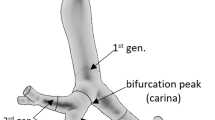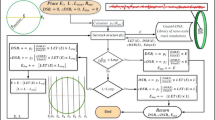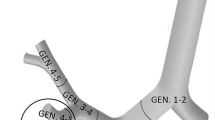Abstract
The calculating the probability of the cell killing per hit, from radon progeny, requires the development of morphometric model of the human airway system. This study is focused on the different modeling concept. For example, several morphometric lung models have been published which differ in terms of airway structure and lung volume, there by affecting the particle deposition efficiencies. The present variety of modeling concepts suggests that the choice of specific modeling assumptions is as important for dose risk estimates as the choice of proper parameter values. The model of human lung analysed in the present study differ from those employed in the ICRP66 model, dose estimates will consequently differ from ICRP66 predictions, because its included the area of the branching the cylinders (airways tube) in the human lung. A analytical model cylinder bifurcation was created to simulate the geometry of human lung with the geometric distribution of cell nuclei in the airway wall of the tracheobronchial tree. Reported probabilities are calculated for various targets and alpha particle energies in order to show dependence of the probability of cell killing per hit from alpha particle energies and the geometry of tracheobronchial tree for the human lung, created in this study.










Similar content being viewed by others
References
Calin MR, Calin MA (2010) Evaluation of the radon concentration in Ocna Dej salt mine Romania. J Radioanal Nucl Chem 286:169–173
Darko EO, Adukpo OK, Fletcher JJ, Awudu AR, Otoo F (2010) Preliminary studies on 222Rn concentration in ground water from selected areas of the Accra metropolis in Ghana. J Radioanal Nucl Chem 283:507–512
ICRP Human respiratory tract model for radiological protection (1994) A report of a task group of the international commission on radiological protection. I.C.R.P. Publication 66, Pergamon Press, New York
Hofman W, Balashazy J, Heisfracher T (2001) The relationship between secondary flows and particle deposition patterns in airway bifurcations. Aerosol Sci Technol 35:958–968
Hofman W, Balashazy J, Koblinger L (1995) The effect of gravity on particle deposition patterns in bronchial airway bifurcations. J Aerosol Sci 26:1161–1168
Martonen TB, Guan X, Schreck RM (2001) Fluid dynamics in airway bifurcations. I. Primary flows. Inhalation Toxicol 13:261–279
Martonen TB, Guan X, Schreck RM (2001) Fluid dynamics in airway bifurcations. II. Secondary currents. Inhalation Toxicol 13:281–289
Martonen TB, Guan X, Schreck RM (2001) Fluid dynamics in airway bifurcations. III Localized flow conditions. Inhalation Toxicol 13:291–305
Nikezić D, Novaković B, Yu KN (2003) Absorbed fraction of the radon progeny in human bronchial airways with bifurcation geometry. Int J Radiat Biol 79(3):175–180
Nikezić D, Yu KN (2003) Absorbed fraction of alpha-particles emitted in bifurcation regions of the human tracheo-bronchial tree. Radiat Environ Biophys 42:49–53
Jovanović B, Nikezić D (2010) Probability of bystander effect induced by alpha-particles emitted by radon progeny using the analytical model of tracheobronchial tree. Radiat Prot Dosim 142(2–4):168–173
Jovanović B, Nikezić D (2011) Probability of bystander effect per mSv induced by α-particle radiation. J Radioanal Nucl Chem. doi:10.1007/s10967-011-1110-2
Jovanović B, Nikezić D (2011) Dependence of the probability of biological effects per hit, induced by radiation emitted by 222Rn, from alpha particle energies and the geometry of tracheobronchial tree. J Radioanal Nucl Chem. doi:10.1007/s10967-011-1201-0
MATHEMATICA®, Available on the web page http://wolfram.com
Palágyia K, Tschirrena J, Hoffman EA, Sonkaa M (2006) Quantitative analysis of pulmonary airway tree structures. Comput Biol Med 36:974–996
Hegedűs CJ, Balásházy I, Farkas Á (2004) Detailed mathematical description of the geometry of airway bifurcations. Respir Physiol Neurobiol 141:99–114
Acknowledgment
This study was supported by Serbian Ministry of Science and Environmental Protection, through the project No 171021.
Author information
Authors and Affiliations
Corresponding author
Rights and permissions
About this article
Cite this article
Jovanović, B., Nikezić, D. & Stevanović, N. Applied mathematical modeling for calculating the probability of the cell killing per hit in the human lung. J Radioanal Nucl Chem 290, 607–613 (2011). https://doi.org/10.1007/s10967-011-1331-4
Received:
Published:
Issue Date:
DOI: https://doi.org/10.1007/s10967-011-1331-4




